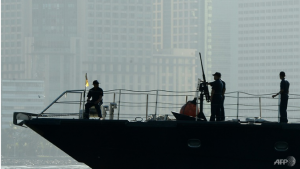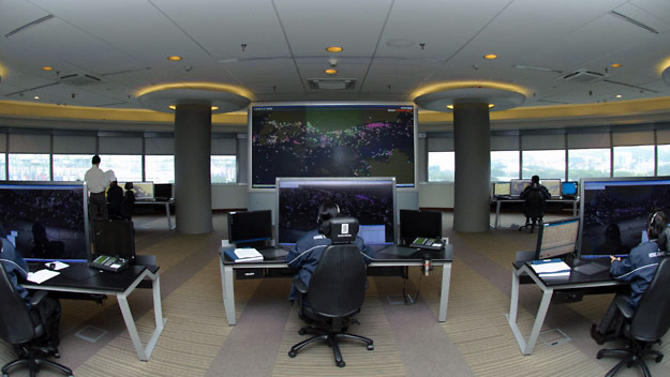SINGAPORE: Being situated at the confluence of the Indian and Pacific Oceans is both a boon and bane for Southeast Asia. On the one hand, this location brings forth trade and commerce shuttling between these two oceans, thereby generating considerable revenues for regional countries such as Singapore.
On the other hand, the busy sea traffic plying through regional waters presents a challenge of its own where it comes to effective surveillance and enforcement against elements which undermine good order at sea, for example pirates and sea robbers.
The Straits of Malacca and Singapore are especially critical, with almost half of the world’s total annual seaborne trade tonnage and 70 per cent of Asia’s energy imports transiting these strategic waterways. From 2015 to last year, international transits through the straits have increased by 3.4 percent.
However, not well-appreciated is the fact that Singapore’s neighbours have vast maritime zones which bring diverse security challenges yet some face capacity constraints with their maritime forces. Singapore’s maritime zone spans about 343 square kilometres, secured by an estimated 143 surface combat and patrol vessels belonging to the navy and police coast guard.
Indonesia by comparison has a total maritime zone covering over five million square kilometres policed by about 239 equivalent vessels. Another example, the Philippines, has almost two million square kilometres of maritime zone covered by about 139 such vessels.
RESPONSIBILITY IN POLICING WATERS LIE WITH LITTORAL STATES
 But the situation is more nuanced in Southeast Asia with its peculiar historical and geopolitical context that conditions the way regional governments go about maritime security cooperation. The fundamental principle behind such cooperation envisages that responsibility in policing regional waters lie with the littoral states although external technical and training assistance are welcomed. This has been the case for the Straits of Malacca and Singapore.
But the situation is more nuanced in Southeast Asia with its peculiar historical and geopolitical context that conditions the way regional governments go about maritime security cooperation. The fundamental principle behind such cooperation envisages that responsibility in policing regional waters lie with the littoral states although external technical and training assistance are welcomed. This has been the case for the Straits of Malacca and Singapore.
A persistent sensitivity towards upholding national sovereignty is reflected in the creation of the Malacca Strait Patrols which started in 2006. It is this very principle that forecloses the option of internationalising maritime security in regional waters.
Yet, over the years, the four littoral states concerned – Indonesia, Malaysia, Singapore and Thailand – have demonstrated their ability to work around sovereignty concerns and put forth a collective solution to address a common maritime security threat.
Maritime cooperation among these countries plays a critical role in the overall improvement of piracy and sea robbery situation in Asia. More recently, reported incidents have more than halved from 2015 to 2016.
But the focus on piracy and sea robbery has since shifted from the Straits of Malacca and Singapore to the Sulu Celebes Seas where a spate of kidnap-for-ransom incidents have taken place since March 2016 – which led to some observers dryly referring to the waters as the “new Somalia”.
INSTRUCTIVE LESSONS FOR SULU CELEBES SEAS
What happened back in the early-2000s, when the Straits of Malacca and Singapore faced an upsurge in piracy and sea robbery attacks, has been instructive for Southeast Asian countries. The shipping industry first called for “internationalising” Malacca Strait security under a United Nations mandate. Direct external intervention appeared imminent after Washington proposed the Regional Maritime Security Initiative, which envisaged American policing of the strait in 2004.
To compound matters, in June 2005, Lloyd’s Joint War Committee labelled the Malacca Strait amongst other areas as being at risk of “war, strikes, terrorism and related perils”. Insurers consequently raised premiums for these high-risk zones, including those for vessels transiting through the Malacca Strait. For a shipping industry already enduring high operating costs due to the sharp increase in energy price, the result was disastrous. All these developments galvanised the littoral states to establish the Malacca Strait Patrols.
MARITIME SECURITY ARRANGEMENTS TREND TOWARDS MINI-LATERAL SET-UPS
But progress has not been as rapid as many desired. One factor concerns sovereignty, particularly claims over Sabah between Kuala Lumpur and Manila. Another factor concerns the need for each government to coordinate and harmonise efforts between national agencies which play varying roles in contribution to this new trilateral mechanism.
Notwithstanding the intramural challenges Southeast Asian littoral states face, it is likely that so-called “mini-lateral” setups – revolving around small groups of countries sharing the same local maritime geographical space and common security challenges – would be the trend of future maritime cooperation in the region.
The Malacca Strait Patrols have proven that such mini-lateral frameworks can be effective in sidestepping the complexity of having to navigate around the needs of too many actors within a much broader, multilateral setup. The Trilateral Cooperative Arrangement is tipped to become the next success story for Southeast Asia.
That said, apart from external cooperation with one another, Southeast Asian governments will have to tackle the more persistent capacity constraints faced by their maritime forces, as well as inter-agency coordination challenges. Arguably, such issues might be just as sensitive.
Koh Swee Lean Collin is research fellow with the Maritime Security Programme, at the S. Rajaratnam School of International Studies based in Nanyang Technological University.
Read more at http://www.channelnewsasia.com/news/asiapacific/commentary-how-to-catch-a-pirate-in-southeast-asia-8762738
